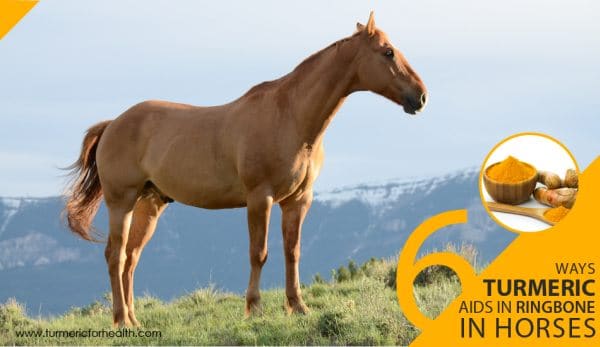Ringbone is a condition involving the excessive growth of bone tissue in the pastern or coffin joint of the horse (these are joints located near the hoof region).
This growth can at times around the joints and hence the name ringbone.
It is considered as a degenerative bone disease; more of a form of osteoarthritis of these joints.
Based on the location affected ringbone is classified as:
- High ringbone: This affects the upper part of small pastern bone.
- Low ringbone: This affects the lower part of the small pastern bone.
Causative factors include excessive tension to ligaments and joints around the pastern joint, osteoarthritis, trauma to this joint and also the natural structure could be such that it predisposes the horse to ringbone development.
Symptoms include pain, swelling of affected joint, a bony bump and in late stages even lameness.
Medications that are generally prescribed for this condition include non-steroidal anti-inflammatory drugs and steroids to ease out pain and inflammation.
Invasive treatment modules include shockwave therapy, microcurrent technology, and arthrodesis.
Please feel free to use the Table of Contents below to jump to the relevant section in the article.
Table of Contents
6 Ways Turmeric Benefits in Ringbone in Horses?
Turmeric can help in Ringbone in horses in several ways. Turmeric is a great anti-inflammatory and anti-oxidant which helps in the disorder.
Turmeric’s natural painkilling properties without side effects can be used to treat the symptoms of ringbone.
Further its anti-arthritic and bone-protective properties can help prevent ringbone in horses.
Research today has changed turmeric’s identity. It is no longer just a kitchen spice. It is a natural painkiller, antioxidant, anti-inflammatory and probably ‘anti-every disease’. Here is how turmeric could benefit in ringbone.
1. It has anti-inflammatory property
In ringbone, the excessive growth of bone tissue around the pastern joint is characterized by inflammation which manifests as pain and swelling.
Turmeric and its active component curcumin are strong anti-inflammatory agents.

- Decreasing the activity of inflammatory enzymes like COX and LOX
- Decreasing the activity of proteins involved in inflammation like Interleukins, TNF-alpha
- Preventing migration of immune cells to site of inflammation
- Inhibiting the activity of the master protein that regulates inflammation-nuclear factor kappa B
- Increasing the activity of anti-inflammatory agents in the body
These properties of curcumin can be beneficial in reducing inflammation, swelling, and pain without causing side effects.
A study investigating the effect of various plant-based antioxidants on inflammation in horses reported that curcumin at low doses helps in attenuating inflammation that would require high doses of non-steroidal anti-inflammatory drugs.
Also, no side effect was observed.
What does this mean?
Curcumin’s anti-inflammatory property aids in reducing inflammation and pain in ringbone.
2. Curcumin is an excellent antioxidant
Oxidative stress is a common feature observed in osteoarthritis. It is an imbalance between prooxidant and antioxidant agents in the body. The use of antioxidant supplementation is implied in the treatment of osteoarthritis.
In a clinical trial, it was observed that curcuminoids at high doses reduced the levels of oxidizing enzymes and increased the levels of antioxidant enzymes thereby mitigating the oxidative stress in osteoarthritis.
Curcumin’s antioxidant nature is proven to be effective in controlling inflammation in diseases affecting horses.
Neutrophil NADPH oxidase is an enzyme that activates immune cells known as neutrophils and produces reactive oxygen species (ROS) that damage tissues. These are major components in any disease affecting horses.
A study demonstrated that curcumin strongly binds to this enzyme and prevents it from forming ROS or activating neutrophils , and hence can be used to treat human and horse pathologies.
Derochette et al have also reported similar results and they comment that curcumin can be a viable alternative to conventional drugs in treating inflammation in horses.
What does this mean?
Research shows that curcumin’s antioxidant property is effective in controlling inflammation and oxidative stress in osteoarthritis.
3. It has anti-arthritic property
Curcumin is considered as one of the nutraceuticals that can aid in the treatment of osteoarthritis by virtue of its anti-inflammatory property.
It exerts its anti-arthritic property by:
- Reducing inflammation in multiple ways
- Reducing activation of immune cells
- Preventing degradation of bone tissue
- Attenuating pain and joint stiffness
As an anti-arthritic agent, curcumin is found to inhibit cartilage degradation and pain in an animal model of osteoarthritis.
Clutterbuck et al conducted a study wherein they studied the effect of curcumin on cartilage tissue from horse joints. Osteoarthritis like the experimental model was developed. It was observed that curcumin inhibited the activation of inflammatory chemicals in cartilage tissue and protected them from degradation that occurs in osteoarthritis.
What does this mean?
Ringbone is considered as a form of osteoarthritis. Turmeric’s anti-arthritic activity can help in reducing inflammation, pain and joint degradation occurring in osteoarthritis.
4. It can serve as an alternative to regular painkillers
Non-steroidal anti-inflammatory drugs, as well as steroids, are prescribed in ringbone to manage pain and inflammation.
Curcumin acts by the same mechanism as these drugs but does not cause any side effect such as gastric erosion which is why it is considered as an alternative to regular painkillers.
Phenylbutazone or bute is a very common painkiller that is prescribed to horses; interestingly experimental study shows that curcumin is better than phenylbutazone in reducing pain.
Indomethacin and diclofenac sodium are the conventional painkillers prescribe in arthritis treatment and curcumin is proven to be better them in terms of anti-inflammatory property.
Celecoxib is a non-steroidal anti-inflammatory drug that is prescribed to manage pain and inflammation in arthritis in humans and horses. A study shows that curcumin works in a combination of celecoxib in reducing inflammation and can reduce the dose of celecoxib required for treatment.
One study proves that curcumin enhances the anti-arthritic effect of prednisolone, a steroid.
What does this mean?
Few research studies point out that curcumin is more effective in reducing pain and inflammation than non steroidal anti-inflammatory drugs and steroids like prednisone, phenylbutazone and indomethacin. Also it does not cause adverse effects.
5. Turmeric has bone protective property
There are three principal types of bone cells:
- Osteoblasts- They lay down new bone material.
- Osteoclasts- They absorb the old bone material.
- Chondrocytes- They form the part of cartilage- the bone tissue present at your nose tip and ears.
Bone turnover is a balancing process wherein osteoclasts absorb old bone and osteoblasts lay down new bone. This process is hampered in osteoarthritis; there is excessive absorption by osteoclasts which leads to weak bones.
A novel formulation of curcuminoids is found to reduce osteoclast activity and maintain osteoblast function, thus normalizing bone turnover process and slowing down osteoarthritis.
Studies on human chondrocytes show that curcumin is chondroprotective and protects these cells from inflammation. Curcumin’s use with other chondroprotective agents is validated.
Curcumin in combination with glucosamine and chondroitin sulphate is proven to be effective in reducing pain and improving movement in humans suffering from knee osteoarthritis.
What does this mean?
Curcumin offers bone protective property which can aid in creating a balance between bone absorption and degradation process occurring in ringbone.
6. It has anti-microbial property

Curcumin has anti-fungal activity comparable to ketconazole, an anti-fungal medication and even turmeric oil possesses anti-fungal property.
Research studies prove that anti-microbial activity of turmeric is comparable to antibiotics such as ampicillin, amoxicillin, etc.
Turmeric is found to be effective against multidrug-resistant strains of bacteria.
These findings are of relevance in protecting the joints in case of infective arthritis.
What does this mean?
Curcumin’s broad spectrum anti-microbial property can help in case of infection that may occur in the joints that are affected by ringbone and osteoarthritis.
Real Pet experience with Turmeric
This experimental study (it was under real-life settings though) by Tom Schell, a vet who specializes in horse-related condition sheds some light on the use of turmeric in osteoarthritis and ringbone.
Two separate trials were conducted. A formulation of curcumin, vitamin E and vitamin C once daily with feed for 30 days. The first trial was on 2 horses and the second included 6 horses; all suffering from a varying degree of osteoarthritis.
Prior medications included bute and steroids. It was observed that lameness score improved by at least one grade in all horses, while the majority of the horses improved by 2 grades.
One of the horses in the trial suffered from ringbone, and post the curcumin treatment one-grade improvement in lameness was seen in this horse. Some of the horses improved so well that they were removed from the daily administration of joint supplements and painkiller, phenylbutazone.
Blood tests also showed a reduction in inflammatory parameters. Overall 80% improvement was perceived by owners and doctors.
Dosage
There is no set dose of turmeric for horses. Most owners start with1 teaspoon of turmeric twice a day. You just need to whip a paste of turmeric, black pepper and some oil to ensure that turmeric is well absorbed in the body.
In fact, you can use the same Golden Paste that you consume for your horse.
If you plan to prepare the paste for every feed then here is how to do it:
Take about 125 ml turmeric powder and add this with 250 ml water to a pan. Cook on low flame till you make a good paste.
Add the water slowly such that the paste is neither watery nor thick. You could add more turmeric powder if the paste is watery and more water if it is too thick.
Then add about 1 1/2 (7.5ml) teaspoon of freshly ground black pepper and 70 ml of oil. You could use coconut or olive or flaxseed oil. Keep stirring till all the ingredients are mixed properly. Let the mixture cool down.
Add around 1 teaspoon to your horses feed once a day and add a lot of water to the feed to mellow down the spicy taste. This is just a start. Slowly increase it to twice a day based on how it suits your horse.
Avoid using oil if the feed is already rich in fats. Also, mix a lot of water in the feed while adding turmeric as horses find this combination more palatable.
Turmeric can also help in other horse health issues –
Read – Turmeric benefits for Horse Arthritis
Read – Turmeric benefits for Greasy Heel
Read – Turmeric benefits for Equine Sarcoids
Read – Turmeric benefits for Laminitis
Precaution
There are no such side effects of feeding turmeric to horses. Initially slight gastric discomfort and diarrhea could occur. In that case, it is advisable to reduce the dose.
Also, avoid turmeric prior to surgical procedures to avoid the risk of bleeding.
Turmeric finds its use as herbal medicine in Trinidad and it is said to flush out the uterus. This could have implications for equine gestation and postpartum health.
Conclusion
Turmeric‘s therapeutic efficacy with respect to ringbone needs adequate research. However, its pain reducing, anti-inflammatory, bone protective and antioxidant property can aid in attenuating symptoms of ringbone as well as benefit in overall treatment.
In case you have used turmeric for your horse, then please share your experience with us.


I am wondering how long the turmeric mixture would last? Could you mix a large batch to hold over for a while, or would it go bad after “a” amount of time?
Also, I just found out my 2 year old gelding has severe osteoarthritis and could be acutely lame in just a few years. I am beginning to look into options to help slow/stop his condition from worsening, if possible, and am very interested in trying turmeric!
I am currently treating an aged paint mare with homeopathic remedies for her osteoarthritis and ringbone diagnosed by our licensed veterinarian. I have always been interested in the healing uses of tumeric but have not persued using it. This presentation has sold me to explore Tumeric further and begin use treating this mare. Are there any dangers or ill effects to the mare by adding Tumeric treatment to the daily use of the homeopathic remedies? I don’t want any harm to occur. I look forward to your response or referral to further my education. Thanks, Mary
Turmeric in diet would not interfere with any other medications or remedies. You can safely include turmeric in her diet and avoid giving other meds close to it to be on the safe side.